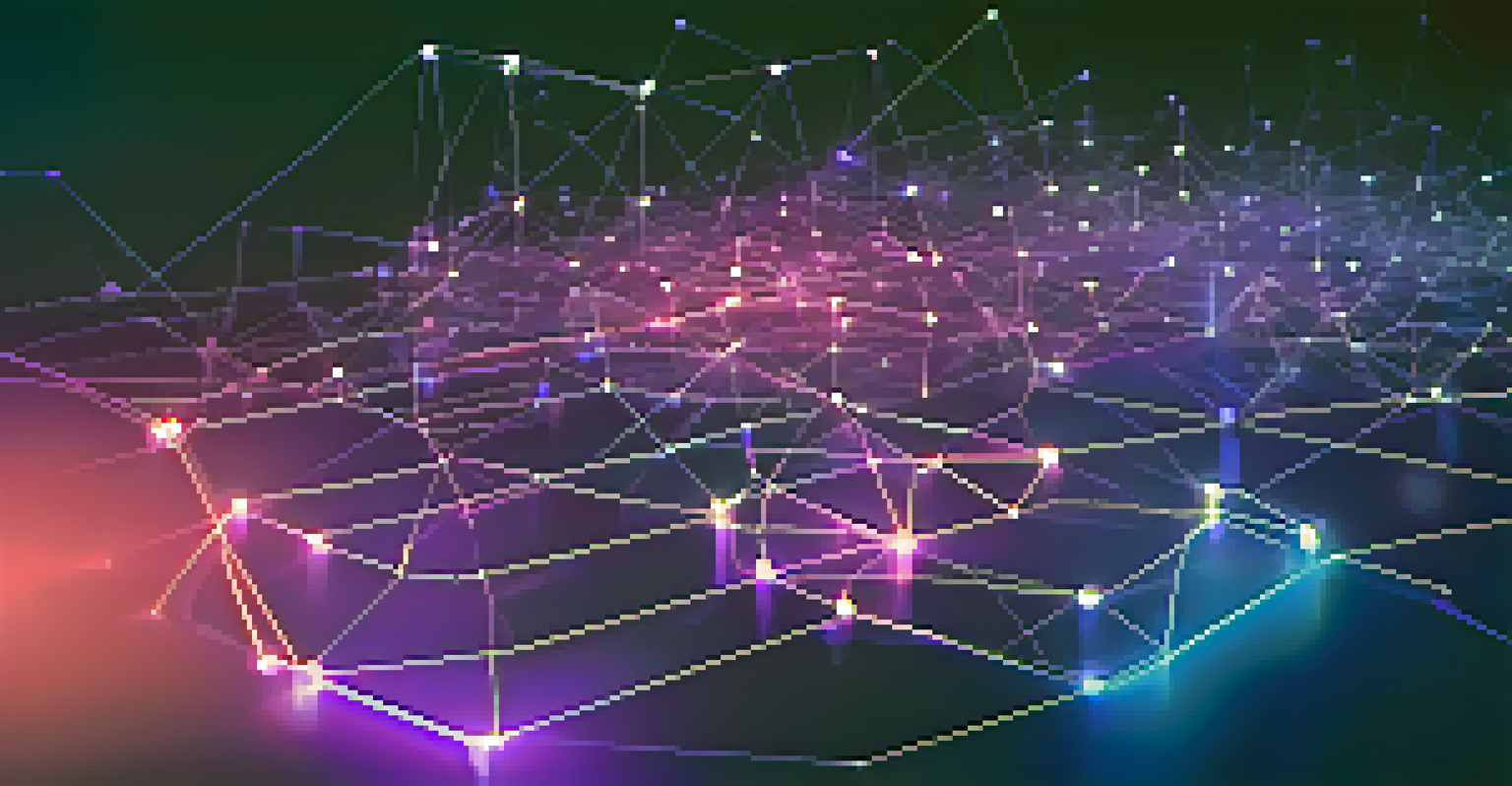NFTs and Intellectual Property: Ownership in the Digital Age

Understanding NFTs: What Are They Really?
Non-fungible tokens, or NFTs, are unique digital assets verified using blockchain technology. Unlike traditional currencies or cryptocurrencies, NFTs cannot be exchanged on a one-to-one basis, making each token distinct. This uniqueness is what gives NFTs their value, especially in the realms of art, music, and collectibles. Imagine owning a one-of-a-kind digital painting that only you possess, thanks to the secure ledger of the blockchain.
The internet is becoming the town square for the global village of tomorrow.
NFTs have gained immense popularity, often touted as the future of digital ownership and art. Artists can tokenize their work, allowing them to sell it directly to consumers without intermediaries. This has not only opened new revenue streams for creators but also transformed how we think about ownership in the digital space. Just as owning a physical painting brings joy and pride, owning an NFT offers a similar emotional connection.
However, with this new form of ownership comes a host of questions, particularly around intellectual property rights. As more people invest in NFTs, understanding the legal implications becomes crucial. What does it mean to own an NFT, and how does it relate to the underlying intellectual property?
The Intersection of NFTs and Intellectual Property
Intellectual property (IP) refers to creations of the mind, like inventions, literary works, and designs. When someone purchases an NFT, they typically acquire the token itself, not the underlying IP rights unless explicitly stated. This distinction is essential for both buyers and creators, as it affects how the digital asset can be used or shared. Think of it like buying a print of a famous painting; you own the print, but the artist retains the rights to the original work.

The lack of clarity around IP rights in the NFT space can lead to confusion and disputes. For instance, if you own an NFT of a digital artwork, can you reproduce it on merchandise or use it in a commercial setting? These questions highlight the importance of understanding what rights are transferred with an NFT purchase. As the market evolves, so too must our understanding of these rights.
NFTs: Unique Digital Ownership
NFTs are distinct digital assets that provide a new form of ownership in art and collectibles, verified by blockchain technology.
Creators must also navigate these waters carefully to ensure they retain the rights they wish to preserve. By clearly outlining the terms of ownership in the NFT contract, artists can protect their work while still benefiting from the sale. This balance of rights and ownership is critical for sustainable growth in the NFT market.
Legal Challenges in the NFT Space
As NFTs continue to grow in popularity, legal challenges are emerging that call into question existing IP laws. Current regulations often struggle to keep pace with the rapid evolution of digital assets. This gap can create uncertainty for both creators and collectors regarding their rights and obligations. Imagine navigating a maze where the rules change at every turn; that’s what the NFT landscape feels like for many.
Intellectual property has the power to unlock creativity and innovation in ways that can change the world.
One significant issue is copyright infringement. When someone mints an NFT of a piece of art they do not own, it raises questions about who truly holds the rights to that work. Legal battles are already underway, with artists taking action against those who sell their work as NFTs without permission. These cases may set important precedents for how IP is handled in the digital realm.
Additionally, the international nature of the internet complicates matters further. Different countries have varying laws regarding IP, which can lead to conflicts when NFTs are bought or sold across borders. As we move forward, it’s crucial for all parties involved to stay informed about these evolving laws to protect their interests.
The Role of Smart Contracts in NFTs
Smart contracts are self-executing contracts with the terms of the agreement directly written into code. In the context of NFTs, they play a pivotal role in defining ownership and usage rights. When an NFT is minted, the smart contract can specify what rights the buyer has, ensuring clarity in the transaction. Picture a digital handshake that automatically enforces the agreed-upon terms, reducing the likelihood of disputes later on.
These contracts can also include royalty provisions, allowing creators to earn a percentage of sales whenever their NFT changes hands. This feature empowers artists and provides ongoing revenue streams, which is a significant shift from traditional art sales. Just as musicians earn royalties from played songs, artists can benefit from the resale of their digital work.
Intellectual Property in NFTs
Understanding the distinction between owning an NFT and the underlying intellectual property rights is crucial for buyers and creators.
However, the effectiveness of smart contracts depends on their design and the clarity of the terms included. If the contract does not adequately convey the rights associated with the NFT, misunderstandings can arise. Therefore, both creators and buyers must take the time to review these terms carefully, ensuring that they fully understand what is being agreed upon.
Navigating Ownership Rights in the NFT Market
Navigating ownership rights in the NFT market requires a solid understanding of both the technology and the legal landscape. Buyers should approach NFT purchases with the same diligence they would when buying physical art or collectibles. This means researching the creator, understanding the terms of the sale, and being aware of the rights being transferred with the NFT. Just like you wouldn’t buy a car without reviewing the title, you shouldn’t acquire an NFT without knowing what you’re getting.
For creators, it's essential to communicate clearly about what buyers can and cannot do with their NFTs. Providing detailed descriptions of rights in the NFT listing can help set expectations. This transparency fosters trust between artists and collectors, creating a more robust marketplace. Think of it as a friendly conversation about rules before starting a game; it sets everyone up for success.
As the NFT landscape continues to evolve, ongoing education will be key for both buyers and creators. Keeping abreast of changes in technology, law, and market trends will help everyone make informed decisions. The more knowledge everyone has, the more vibrant and sustainable the NFT ecosystem can become.
The Future of NFTs and Intellectual Property Rights
The future of NFTs and intellectual property rights is still being written, but it holds exciting possibilities. As technology advances, we may see new frameworks and regulations that better address the unique challenges posed by digital assets. These changes could lead to clearer guidelines for ownership and usage rights, making it easier for everyone involved. Imagine a world where the rules of digital ownership are as clear as those for physical assets.
Moreover, as NFTs become more mainstream, we may witness a cultural shift in how we perceive ownership in the digital age. Just as the internet transformed how we access information, NFTs could change how we view art, music, and collectibles. This shift may lead to greater appreciation for digital creators and their work, fostering a more inclusive environment for all types of artists.
Legal Challenges Ahead
The evolving NFT landscape presents legal challenges related to copyright and international laws that necessitate ongoing education and adaptation.
Ultimately, the relationship between NFTs and intellectual property will be shaped by ongoing dialogue among artists, buyers, and legal experts. As we adapt to this new landscape, open discussions will be vital in navigating the complexities of ownership. This collaborative approach can help ensure that the rights of all parties are respected and that the NFT market continues to thrive.
Conclusion: Embracing the Digital Ownership Revolution
In conclusion, NFTs have ushered in a new era of digital ownership, bringing both opportunities and challenges. As we explore the intersection of NFTs and intellectual property, it’s essential to stay informed and engaged. By understanding the nuances of ownership rights, both creators and collectors can navigate this evolving landscape with confidence. Embracing this revolution in digital ownership allows us to appreciate the unique value that NFTs bring to the table.
The potential for creators to monetize their work directly and for collectors to own unique digital assets is game-changing. However, this new frontier also requires us to think critically about what it means to own something in the digital age. As we forge ahead, it’s crucial to foster a culture of transparency and respect for intellectual property rights.

By doing so, we can create a vibrant and ethical NFT ecosystem that supports artists and engages collectors. The digital age is here, and with it comes the responsibility to navigate it thoughtfully and collaboratively. Let’s embrace this journey together and redefine ownership in the world of digital art and beyond.